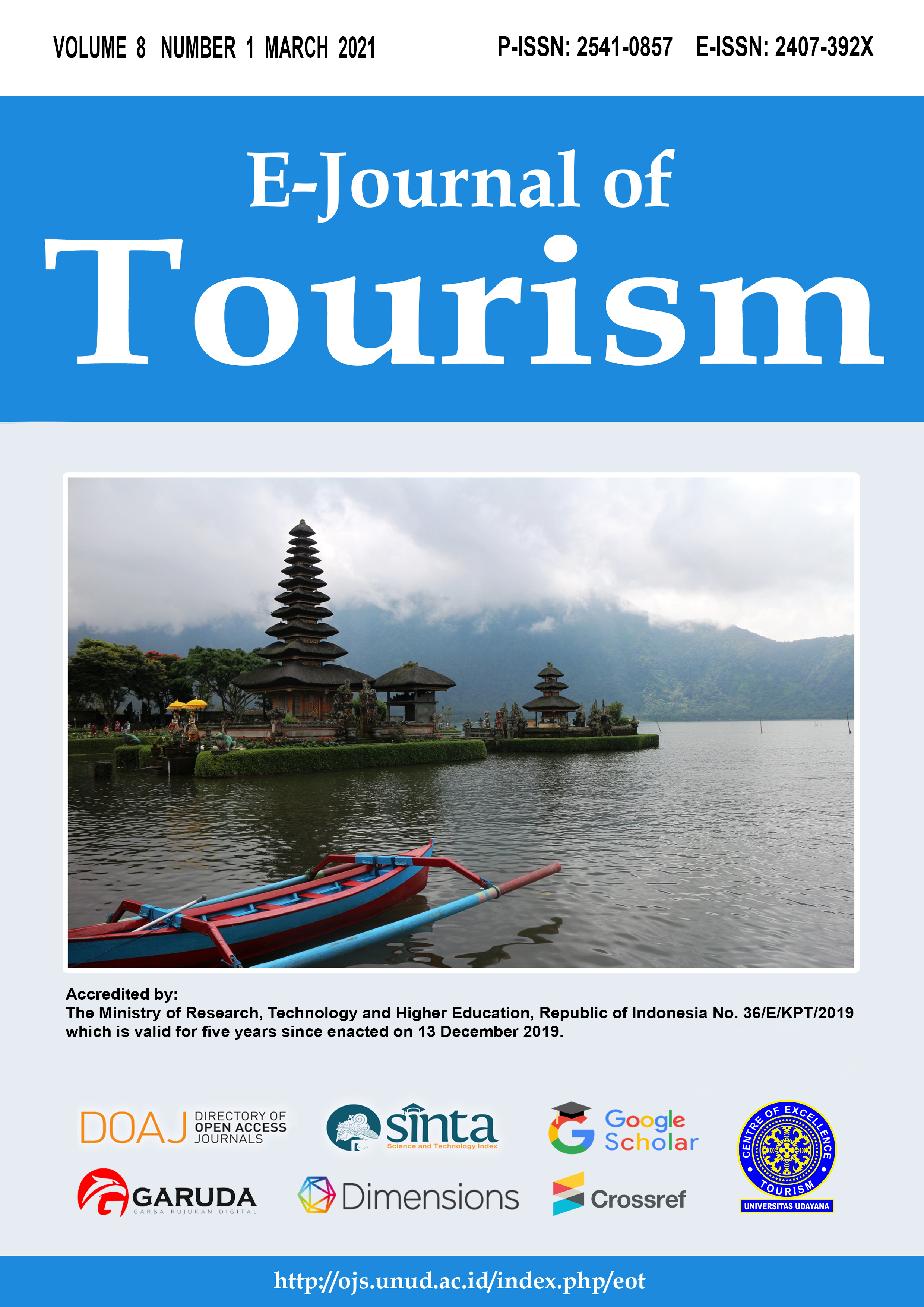E-Tourism as A Promotion Media for Cimande Tourism Village
Abstract
Cimande Tourism Village promotion is done to provide information to potential visitors about the tourism potential in the region. Promotion using the website (e-tourism) is believed to convey information more clearly and widely. This research was conducted in Cimande Tourism Village, in Caringin District, Bogor Regency. Research uses qualitative descriptive methods. The research object is Cimande tourism village website’s with access desawisatacimande.com. The result discover that Cimande tourism village website has a fairly good level of visibility by using search engines namely Google, Yahoo and Bing. Promotional techniques are carried out by linking information related to tourism, namely information about the activities of Cimande Tourism Village itself. Online public relations not yet available. The websites email are available even though they are still minimal in use. The manager has not recorded the visitors so the ranking related to the visitor does not exist. Therefore, the author recommends that managers work together with other institutions to meet human resources needs in order to improving knowledge and skills related to the promotion, especially for websites. In addition, the manager can also ask the relevant institutions to cooperate in the promotion activities of Cimande Tourism Village.
Downloads
References
Anshar, A. and Batubara, R. P. (2019) ‘Analisis Penerapan Prinsip Ekowisata Di Kebun Raya Bogor’, Bogor Hospitality Journal, 3(2), pp. 1–8.
Batubara, R. P. (2020) ‘Strategi Pengembangan Oukup sebagai Ekowisata Kesehatan Kabupaten Karo’, Jurnal Ilmiah Pariwisata, 25(2), pp. 121–132.
Fernández-Cavia, J. et al. (2014) ‘Web Quality Index (WQI) for official tourist destination websites. Proposal for an assessment system’, Tourism management perspectives, 9, pp. 5–13.
Handayani, I., Febriyanto, E. and Shofwatullah, M. (2019) ‘Optimalisasi visibilitas situs iLearning Journal Center (iJC) Pada Mesin Pencari Berbasis Search Engine Optimization (SEO) On Page’, Sains dan Teknologi Informasi, 5(1), pp. 27–35.
Joshi, P. (2012) ‘A Stakeholder Networking for Sustainable Rural Tourism Development in Konkan Region of Maharashtra State (India)’, Reseach Paper, 1.
Ku, E. C. S. and Chen, C.-D. (2015) ‘Cultivating travellers’ revisit intention to e-tourism service: the moderating effect of website interactivity’, Behaviour & Information Technology, 34(5), pp. 465–478.
Marpaung, H. and Bahar, H. (2002) ‘Pengantar pariwisata’, Bandung: Alfabeta.
Noviyanti, S. (2014) ‘E-Tourism: bentuk promosi pariwisata Indonesia selanjutnya’, Kompas Gramedia, Jakarta.
Pearce, D. (1995) ‘Tourism a Community Approach. 2nd: Harlow Longman’. Washington. DC (US): Island Press.
Santoso, D. B. (2009) ‘Pemanfaatan Teknologi Search Engine Optimazion sebagai Media untuk Meningkatkan Popularitas Blog Wordpress’, Dinamik, 14(2).
Sari, D. P. (2017) ‘The Process of Making Tempe Benguk as Tourist Attraction in Kulon Progo Yogyakarta’, E-Journal Of Tourism, pp. 78–84.
Sari, D. P. (2018) ‘Apakah Ada Peranan Aktivitas Wisata Dalam Peningkatan Ekonomi Daerah Di Kota Bogor?’, Barista: Jurnal Kajian Bahasa dan Pariwisata, 5(1), pp. 12–22.
Sari, D. P. (2019) ‘Motivation towards Inbound Tourism: A Study of Middle East Tourist’, E-Journal of Tourism, pp. 235–251.
Sebastia, L. et al. (2009) ‘e-Tourism: a tourist recommendation and planning application’, International Journal on Artificial Intelligence Tools, 18(05), pp. 717–738.
Stankov, U., Ćurčić, N. and Dragićević, V. (2010) ‘Assessment of forms and extent of tourism web promotion in Serbia’, Journal of the Geographical Institute” Jovan Cvijic”, SASA, 60(1), pp. 57–68.
Sugiarti, R. (2008) Geografi Perdesaan Sebuah Antologi. Yogyakarta: IdeAs Media.

This work is licensed under a Creative Commons Attribution 4.0 International License.
The copyright of the received article shall be assigned to the journal as the publisher of the journal. The intended copyright includes the right to publish the article in various forms (including reprints). The journal maintains the publishing rights to the published articles.




















